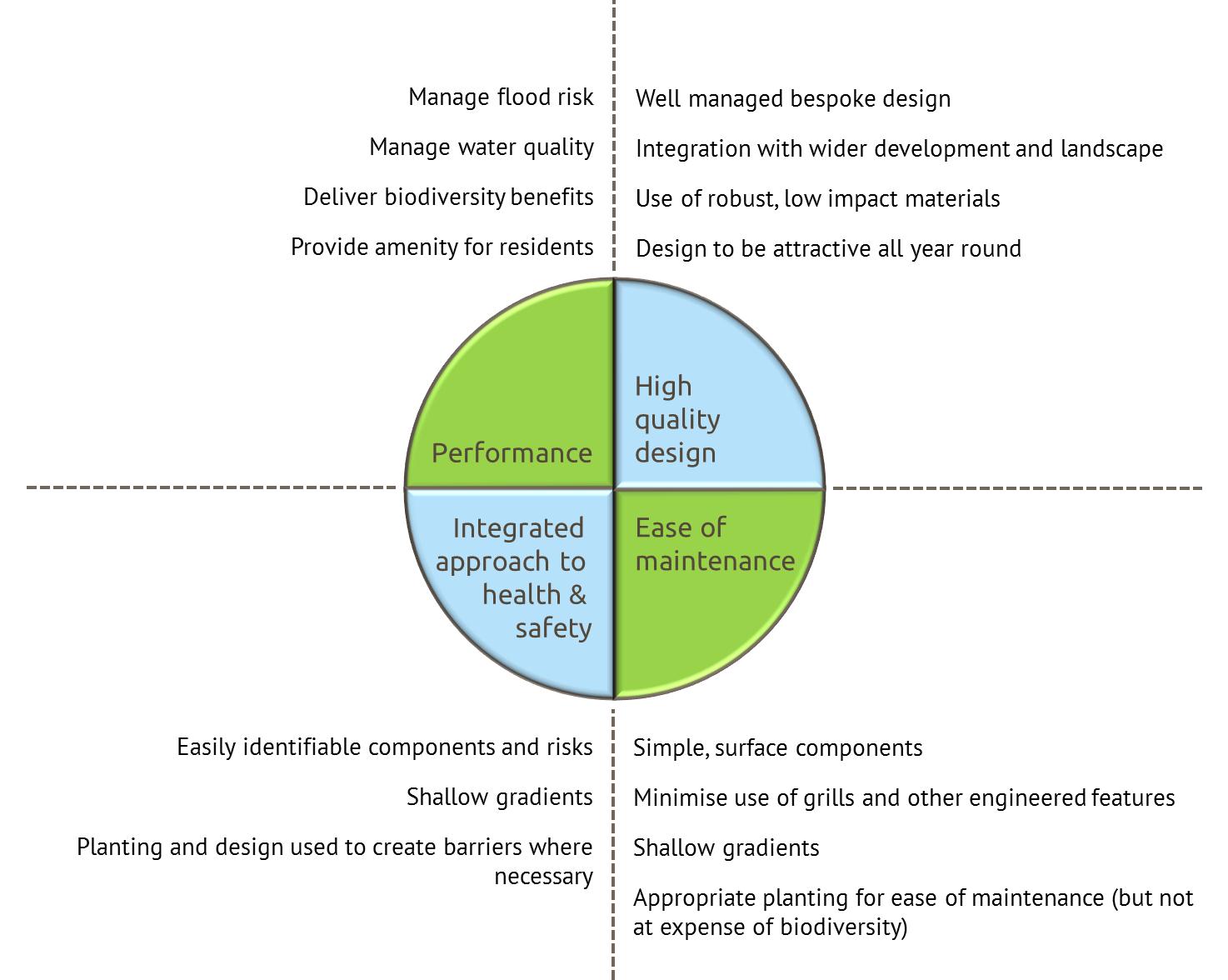- Delivering SuDS
- Using SuDS
- Background
- SuDS principles
- Benefits of SuDS
- Benefits of SuDS
- Why developers should choose SuDS
- Flood risk management
- Water quality management
- Biodiversity & ecology
- Amenity
- Air quality
- Building temperature
- Carbon reduction and sequestration
- Crime
- Economic growth
- Enabling development
- Flexible infrastructure/climate change adaptation
- Education
- Groundwater recharge
- Health and well being
- Pumping wastewater
- Rainwater harvesting
- Recreation
- Tourism
- Traffic calming
- Treating wastewater
- SuDS components
- SuDS components overview
- Source control
- Swales & conveyance channels
- Filtration
- Infiltration
- Retention & detention
- Wetlands
- Inlets, outlets and control structures
- SuDS performance & monitoring
- Delivery
- The costs & benefits of SuDS
- Adoption & maintenance of SuDS
- Legislation & regulation
- Design guidance
- Retrofitting SuDS
- Drainage exceedance
- Home
- Delivering SuDS
- Using SuDS
- Delivery
- Approval
Approval
The implementation of Schedule 3 of the Flood and Water Management Act will have a fundamental impact on this process. Under these regulations any development that has a drainage implication will require approval in line with the National Standards for Sustainable Drainage. The overview of the approvals process provided here is based on the pre Schedule 3 situation, broadly consistent with the principles in the SuDS Manual (C697).
The objectives on approving and accepting SuDS schemes remain the same whether Schedule 3 or the National Standards have been implemented or not. Lead Local Flood Authorities (and other relevant stakeholders) need to be satisfied that SuDS schemes are designed appropriately to manage surface water runoff. They will also need to ensure that SuDS are to an adoptable standard. Many local authorities are in the process of developing their own guidance and standards which will eventually complement the National Standards once they’re implemented.
Principles of approval
As well as the key SuDS principles, the SuDS design philosophy should embrace four elements that contribute to good design (Figure 1). This should help deliver schemes that are robustly designed, sufficiently high quality, easily maintained and not burdened by excessive costs or liabilities. This should help provide multiple benefits over and above reduced flood risks, better water quality and increased biodiversity.
Figure 1 Key design elements for SuDS (after Cambridge City Council 2010)

The process
Early engagement and discussions with the relevant stakeholders is key to a successful SuDS scheme. Integrating the SuDS scheme into the development master plan at an early stage for large developments is also very helpful. Approval of SuDS schemes at the moment comprises three stages:
1. Conceptual drainage proposals
2. Outline drainage proposals
3. Detailed drainage design
Conceptual drainage proposals
This preliminary stage provides a good opportunity for the developer and local authority to have pre-application discussions. Establishing good communications can potentially reduce the time required for consultation at later stages. This stage allows the developer to present a vision for the site and explain the overall drainage philosophy and proposals for managing surface water runoff.
Key information requirements include:
-
A description and conceptual plan of the development.
-
An overview of the drainage philosophy including an indication of flow routes, SuDS components, storage locations and discharge points.
-
Identify the key design criteria and specific opportunities and constraints for the site.
-
Understand the approaches towards adoption of SuDS (those in the public realm).
Outline drainage proposals
This stage should describe approaches to integrate the SuDS scheme into the development and landscape (and/or public open space). It should provide an overview on how components will be linked and how normal and exceedance flows will be managed (this could be incorporated into a design and access statement). At this stage it shouldn’t be necessary to submit calculations for storage and runoff etc, however any drainage components should be roughly sized.
Key information requirements include:
-
An outline of the SuDS philosophy (opportunities and constraints for the site, ie infiltration suitability, contaminated land etc).
-
An initial SuDS design statement to explain the proposal and demonstrate how source control and the SuDS management train have been incorporated and integrated with the development and landscape.
-
An outline plan of the scheme to demonstrate flow and exceedance routes.
-
Initial calculations of runoff generated and associated storage.
-
An estimation of required storage volumes (and where this will be located).
-
The proposed location and size of SuDS components on the site (shown on an outline plan).
-
Agreement of adoption, maintenance and operation of the scheme.
Detailed drainage design
This is dependent on completing the stages above. Detailed design proposals are submitted for planning purposes and are likely to be required by the adopting organisations.
Key information requirements include:
-
A method statement explaining how surface water will be managed during construction.
-
Final plan of the development and SuDS scheme with levels.
-
A statement of the SuDS scheme detailing the overall philosophy and details on how the scheme meets the previously discussed design criteria.
-
A proposal (where relevant) on how the scheme will be integrated into the development, landscape and public open space.
-
Detailed drawings of all SuDS components for the scheme.
-
Appropriate calculations to demonstrate how storage volumes, and runoff flows have been determined with location and volume of storage.
-
Location and details of inlets, outlets and control structures.
-
Details of low flow pathways, overflow arrangements and exceedance routes.
-
Evidence of soil porosity tests and the location of infiltration components.
-
Details and agreements on the adoption of components and the scheme.
-
A Management Plan (SuDS overview, specification, schedule of work, site plan etc).
Read more on:



